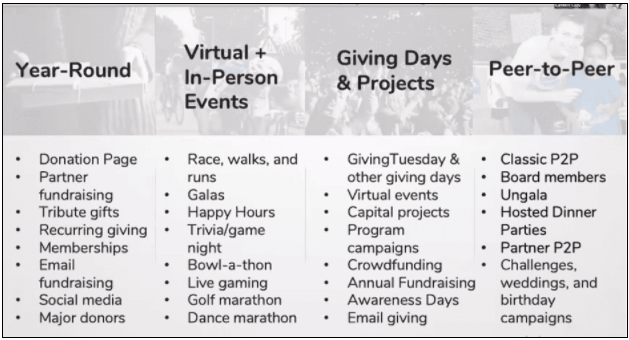Thinking of running a crowdfunding campaign for your nonprofit in 2022? Earlier this year, CauseVox posted this helpful article that details all of the steps you would need to take. You can read the original post on CauseVox.com.
In 2020, the online revenue for nonprofits grew 32%.
If you’re a nonprofit fundraiser who wants to take your organization to the next level, that statistic gives you some big information: fundraising online is an essential part of your fundraising strategy. In fact, the nonprofits that we see withstanding the pandemic with the most ease are the ones that are the quickest to adopt a comprehensive digital fundraising strategy.
And, one of the tried-and-true digital fundraising strategies is crowdfunding.
After seeing thousands of successful nonprofit crowdfunding campaigns, we’ve seen what strategies work the best to drive more donations for your nonprofit.
If you want to run the best crowdfunding campaign for your nonprofit, check out our tips and tricks so that you can capitalize on the powerful growth happening in online giving.
What is crowdfunding?
Crowdfunding is the practice of funding a project or venture by raising small amounts of money from a large number of people, typically via the Internet.
That means any time you’re soliciting your donors for a particular campaign or project online, you’re crowdfunding! You can easily fold crowdfunding into your fundraising strategy by adding it as an element of an event or project that you already do, or simply by participating in a giving day!
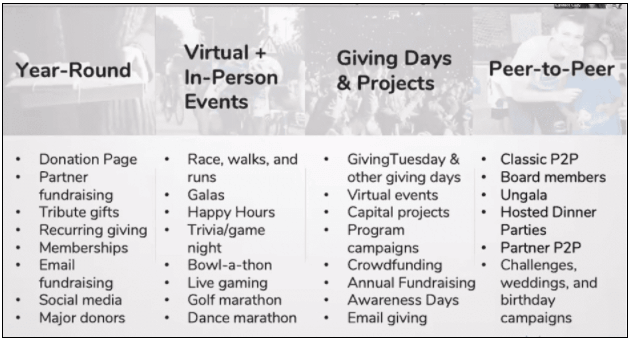
Here are the characteristics of the typical crowdfunding campaign:
- Crowdfunding is particularly helpful to raise money for a specific project, program, or initiative. The more specific, the better. You want to sweat the small stuff.
- Crowdfunding is usually time-based. It’s fun with calendars and countdowns. (Usually between 30-60 days, but sometimes less!)
- Crowdfunding is a great opportunity for extra bells and whistles like prizes and incentives, testing out tiered donation levels, adding on peer-to-peer fundraising, and niche content.
The first step of any crowdfunding campaign is to decide what it will be for, and how you will focus it. Then you can start to plan.
Your nonprofit crowdfunding campaign plan
Like any solid fundraiser, a crowdfunding campaign works the best when you have a clear plan with well-developed goals to guide you and your donors. The easiest way to start building out your plan is by identifying your goals. You’ve most likely heard of SMART goals before. It’s an acronym that stands for:
- Smart
- Measurable
- Actionable
- Realistic
- Time-Bound
As you create goals for your crowdfunding campaign, you’ll want to think about goals that meet these requirements. You’ll end up with better goals that are more helpful in guiding your campaign.
Setting fundraising goals for your crowdfunding campaign
It’s easiest to get started with your overall goals. How much revenue do you hope to bring in? You can create this goal based on previous campaigns and on your larger budget. If you’re hoping to use this campaign to fund a new building, your goal would be the amount you need to build the building. You can also ask yourself what impact you hope to make:
- Who will benefit?
- How many people?
- In what ways?
Using these questions, you’ll be able to create concrete goals for the event as a whole.
From here, you can drive in deeper. Do you want to set a goal for the number of participants you would like? Maybe your goal for this campaign isn’t necessarily reaching a certain dollar amount, but having a certain number of people give. You could also include a goal for board participation, or for sponsorships.
Setting your crowdfunding campaign timeline
Fundraising campaigns work best when they have a clear start and end date.
I like to build my timeline starting from the end and moving backward, especially if my campaign culminates in an event. Consider how much time you’ll need to have the event finalized, and make sure you give yourself plenty of wiggle room to get it done. You’ll also want to think about setup time when you set the start date.
You’ll need to set up a crowdfunding campaign site, create a marketing strategy, build your branding, and have all your materials ready to go. Set your start date so that you have time for all your setup.
We often have people ask us how long the ideal amount of time is for a fundraiser. Of course, there’s no hard and fast answer: depending on the type of campaign you’re running, your organization, your donors, and dozens of other factors, the length of time can vary. But in general, campaigns that run for approximately six weeks tend to do well.
Nonprofit crowdfunding campaign challenge or activity
You can add an extra element by including a challenge or activity. This could be a walkathon or moveathon, or a virtual activity that you aim to send viral (think the ice bucket challenge). These types of activities generally work very well because it engages your donors to do more than just donating or fundraising, and gets them more involved in the event.
No matter what action you choose, make sure you set some parameters:
- Are you limiting it to a specific time frame?
- Is there only one way to participate or will you have multiple options (think a 5K that allows folks to run, walk, bike, or anything else)?
- What is your goal for the activity?
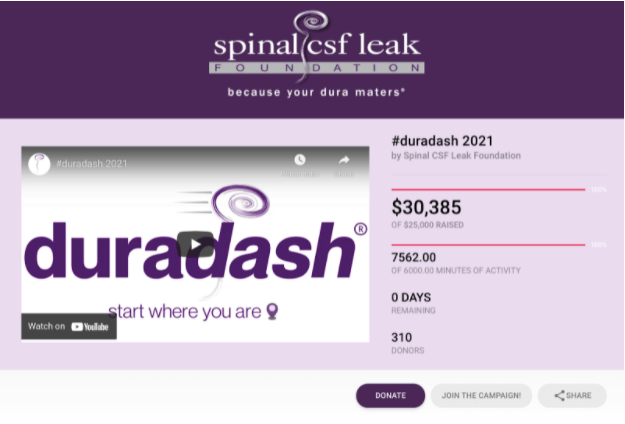
For example, the Spinal CSF Leak Foundation invited supporters to participate in their annual event called Duradash (the name comes from the “dura” matter in the brain, which is where spinal leaks happen). Setting up Duradash as an online fundraiser made it accessible to people with a wide variety of abilities–including walking on a treadmill, riding a bike, sharing content, or meditating. Participants tracked minutes related to any activity and shared more information on their fundraiser page.
Are you tired yet? We’ve covered a lot. If you need a quick refresher, here’s what we went over:
- Set SMART goals, including an overall fundraising and impact goal, and a participant goal
- Create a fundraising timeline
- Plan a challenge or activity
The last piece of the puzzle is to set up your fundraising site. You’ll want to double-check to make sure you’ve included all of these elements before you go live:
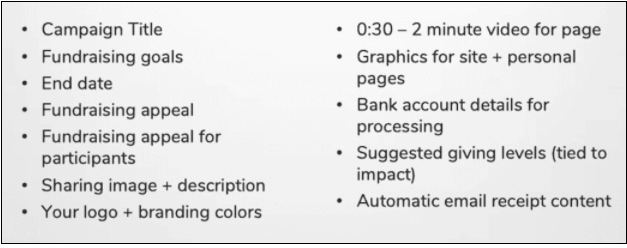
Soft launching your nonprofit crowdfunding campaign
Now that you have your plan you’re ready to get started! Well…sort of. You’re ready to start a soft launch. A soft launch is a powerful marketing technique that just means sharing your fundraising campaign with some hand-picked supporters before you push it out to your larger networks. It helps you build buzz about your campaign, show potential donors that you have support, and create momentum for the larger campaign.
Your soft launch is a way to introduce the campaign and ask for support from a specific group of people. We recommend including:
- Board Members
- Major Donors
- Recurring Donors
- Longtime Donors
- Volunteers
- Members (if applicable)
Once you’ve identified your supporters, figure out what you want from them:
- Are you aiming for them to donate? Suggestion: Set a goal and divide it by the number of people you’re reaching out to; that way you can ask them to donate a specific amount.
- Do you want them to set up a peer-to-peer fundraising page? This is a great time to get your biggest supporters on board so that other potential fundraisers can see the momentum you’ve got.
- Give you feedback on your campaign and provide content for the bigger launch. Your soft launch supporters may have a story to tell, testimonials about your organization, or feedback on the donation process. Include a specific call to action in your soft launch.
A soft launch can really boost a campaign, and we highly recommend using one to get your crowdfunding campaign started on the right foot.
Content creation and marketing for best results for your nonprofit crowdfunding campaign
When you’re ready to launch your campaign, your marketing strategy is going to play a huge role in your success. We’ve all heard it before: storytelling is at the heart of nonprofit fundraising. But how often do you really think about that? Let’s stop and take a moment with that concept.
56% of social media users who donate said that a compelling story is what made them donate.
As you build out the content for your campaign and start to plan your marketing, storytelling should be at the heart of everything you do. If you start with a story, you can build out a fundraising appeal that will be incredibly effective.
We like to use a few guidelines to help us write any fundraising appeal. A great appeal will:
- Communicate what you’re trying to accomplish
- Tell why that matters and what the impact will be if you’re successful
- Tell a story
- Answer the question “why now?”
- Include a clear call to action to donate
Here’s an example from Fiver’s #GivingTuesday crowdfunding campaign appeal:
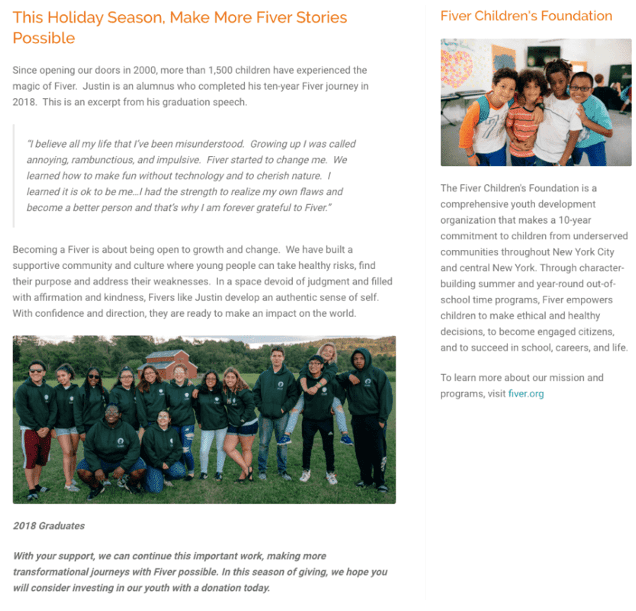
As you think about writing stories, whether in your fundraising appeal or elsewhere, there are a few key points to keep in mind. The best stories that we’ve seen include these elements:
- They’re sourced from the community
- They use quotes and images
- They tell the same story across multiple mediums
- They’re designed to be shared
- They are told from a place of dignity and the storyteller is compensated
Here’s a great example from Stupid Cancer, showcasing how they encourage their community to tell their own stories:

Once you have stories and appeals written, what are you supposed to do with them? Obviously, share them! As you start to push out your campaign to the larger community, you’ll want to reach them through as many channels as you can. Consider using:
- Your website
- Social media
- Direct mail
- Text
- Livestream events
- Radio/TV/media
- Phone calls
Truly the sky is the limit! Any way you can tell a story is a way that you should be reaching out to potential donors. The more you share, the more potential donors will be a part of your campaign.
Nonprofit crowdfunding campaign tips and tricks
Before we wrap up, we’ve got a few little tips that will make any crowdfunding campaign just a little bit better. Make sure you take a quick look at these before you send that campaign out to the world.
- Keep everything in one place! Drive everyone to donate, fundraise, participate, and track progress on a single page.
- Make it so easy to donate. We have tons of resources about setting up your crowdfunding campaign, so make sure to check them out!
- Tie gift amounts to impact.
- Get a match
- Offer incentives to fundraisers
And with that, you’re ready to go!

